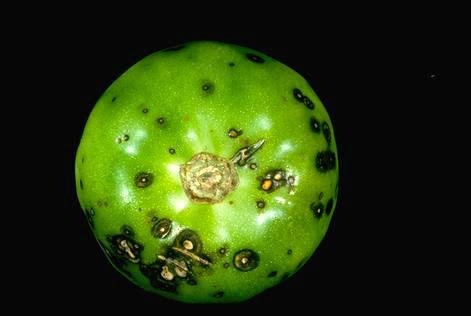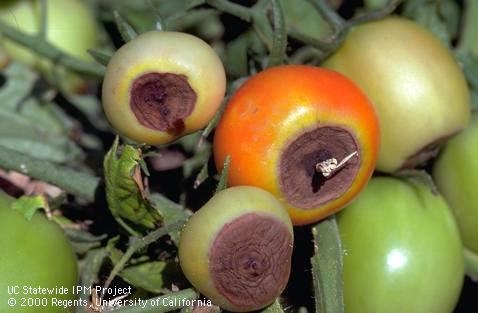Advice from the Help Desk of the
UC Master Gardener Program of Contra Costa County
Subject: Summer Tomato Problems
Client: Came to our Help Desk office with multiple problems with his tomatoes and maybe on his samples of rosemary and rhododendron

First, we discussed the early blight problem on your tomato plants. In particular, we discussed that spores of the early blight fungus in your case were spread by splashing water, so it is important to keep the leaves as dry as possible. We also discussed using mulch to reduce the spread of spores from old infected leaf material in the soil, and using crop rotation techniques. Here is a link to additional information and photographs http://ipm.ucanr.edu/PMG/GARDEN/VEGES/DISEASES/tomearlyblight.html. 
We further identified a disfigurement on the bottom of the tomato fruit as a physiological problem called catfacing. It occurs when weather is too cold during flowering. There is not any way to prevent this but the problem will not spread and the fruits are safe to eat. A link to that information is here http://ipm.ucanr.edu/PMG/GARDEN/VEGES/ENVIRON/catfacing.html

Finally, I looked at the specimens of rosemary and rhododendron leaves you brought in, and confirmed that there were no pests or diseases there. However, both plants appear to be water stressed and should perk up with additional irrigation.
I hope that this information is helpful. Please do not hesitate to ask for advice again. We are here to help.
Help Desk of the UC Master Gardener Program of Contra Costa County (JL)
(all pictures from UCANR links cited above)
Note: The UC Master Gardeners Program of Contra Costa's Help Desk is available year-round to answer your gardening questions. Except for a few holidays, we're open every week, Monday through Thursday for walk-ins from 9:00 am to Noon at 75 Santa Barbara Road, 2d Floor, Pleasant Hill, CA 94523. We can also be reached via telephone: (925) 646-6586, email: ccmg@ucanr.edu, or on the web at http://ccmg.ucanr.edu/Ask_Us/ MGCC Blogs can be found at http://ccmg.ucanr.edu/HortCoCo/ You can also subscribe to the Blog (//ucanr.edu/blogs/CCMGBlog/).